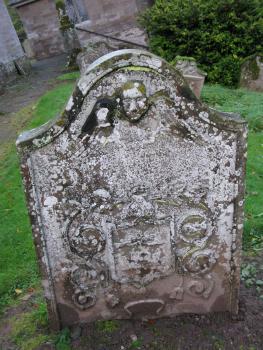Item Details

Work details
- Title
- St Martins Parish Church (also known as Melginch or Megginch)
- Work OCR text
SUMMARY DESCRIPTION
The present church, which dates from 1842, is a basically T-shaped structure, with a lateral aisle projecting from the centre of the south face, and a slight salient capped by a bellcote at the corresponding point of the north face. Nothing visible remains of the medieval church.
HISTORICAL OUTLINE
Probably shortly after 1189, David Huniet or Humet, apparently the secular lord of Melginch, with the assent of his son, Alexander, gave the church to John, bishop of Dunkeld.(1) Bishop John thereupon granted the church to the canons of Holyrood, who had received confirmation of possession from King William by 1199 at the latest.(2) It appears, however, that Bishop John had only made over the patronage of the church to the canons, who did not secure corporal possession until 1228 when Bishop Hugh agreed to the appropriation of the parsonage and vicarage to the abbey.(3) In 1230, the incumbent rector, Walter, resigned his charge in a ceremony at the church into the hands of sir William son of Nicholas, canon and sacristan of Holyrood, in the presence of the bishop and dean of Dunkeld, and Stephen, lord of Melginch. The dean then confirmed William in possession of the church and instituted him as rector.(4) It is possible that his predecessor, Walter, may also have been a canon of Holyrood, for amongst the witnesses to the process was William, chaplain of Melginch, who may have been serving the cure. A vicarage, however, was instituted at some point after this date, being recorded in Bagimond’s Roll.(5) Although on occasion possession of the church could be granted to individual canons of Holyrood, as in 1386 when it formed part of a settlement awarded to David Bell upon his resignation of the abbacy, the parsonage remained annexed to the abbey at the Reformation, with the cure served by a vicar.(6)
ARCHITECTURAL DESCRIPTION
In the entry in the Statistical Account, published in 1794, it was said that the church had been rebuilt in 1776, but it was again rebuilt in 1842, to the designs of Andrew Heiton. The church erected at the latter date occupies a narrow ridge on which there is room for only a small burial ground to its south and west. Since that graveyard contains several monuments predating the church, it appears certain that the present building must occupy the site of its predecessors, and that its construction has obliterated any visible traces of those predecessors.
Within the fabric of the church of 1842 a number of earlier monuments are to be seen. These include a stone of about 1600 that marks the burial place of Henry Drummond of Gairdrum, to the west of the pulpit, and a memorial to Isobel Rollo who died in 1646, set within a wall adjoining the steps to a basement chamber. However, it is unlikely that these indicate the retention of fabric from the earlier church; they were presumably re-set in the later masonry for reasons of family piety.
NOTES
1. Holyrood Liber, no 66.
2. Holyrood Liber, no 48; RRS, ii, no 297.
3. Holyrood Liber, 53.
4. Holyrood Liber, appendix 2, no 13.
5. SHS Misc, vi, 48.
6. CPL, Clement VII, 127n; Donaldson, Thirds of Benefices, 16.
BIBLIOGRAPHY
Calendar of Papal letters to Scotland of Clement VII of Avignon, 1976, ed. C. Burns, (Scottish History Society) Edinburgh, 127n.
Cowan, I.B., 1967, The parishes of medieval Scotland, (Scottish Record Society), Edinburgh, 145.
Donaldson, G. 1949, Accounts of the collectors of thirds of benefices, (Scottish History Society), Edinburgh, 16.
Dunlop, A.I., 1939, ‘Bagimond’s Roll, statement of the tenths of the kingdom of Scotland’, Miscellany of the Scottish History Society, vi, 1-77, at 48.
Gifford, J., 2007, The Buildings of Scotland, Perth and Kinross, New Haven and London, 687-8.
Hay, G., 1957, The architecture of Scottish post-Reformation churches, Oxford, 122, 188, 203, 208.
Liber cartarum Sancte Crucis, 1840, ed. C. Innes, (Bannatyne Club), Edinburgh, nos 48, 53, 66, app. 2 no 13.
New Statistical Account of Scotland, 1845, Edinburgh and London, x, 874.
Royal Commission on the Ancient and Historical Monuments of Scotland, Canmore database.
Royal Commission on the Ancient and Historical Monuments of Scotland, 1994, South-East Perth, an archaeological landscape, Edinburgh, 163.
Scott, A., 1911, St Martins and Cambusmichael, a parochial retrospect, Perth, 59-60.
Statistical Account of Scotland, 1791-9, ed. J. Sinclair, Edinburgh, xiii (1794), 503.
- Work Additional Notes
Dedication: St Martin
Diocese: Diocese of Dunkeld
Deanery: Deanery of Angus
County: County of Perthshire
Council: Perth and Kinross Council
OS: NO 1548 3035
Image details
- Description
- 7. St Martin's Churchyard monument 2
- Full Image Dimensions (WxH)
- 3000x4000 pixels
- Accession Number
- IDB-124289-000867
- Collection
- Corpus of Scottish medieval parish churches








